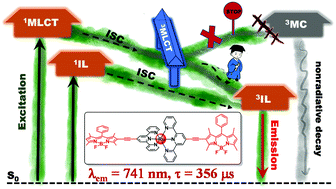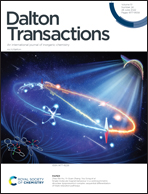BODIPY-conjugated bis-terpyridine Ru(ii) complexes showing ultra-long luminescence lifetimes and applications to triplet–triplet annihilation upconversion†
Abstract
The poor excited-state properties of bis-terpyridine Ru(II) complexes have significantly limited the applications of these complexes as sensitizers in photocatalysis and triplet–triplet annihilation upconversion. In the present work, two novel ruthenium bis-terpyridine complexes (Ru-1 and Ru-2) conjugated with visible-light-harvesting bodipy chromophores were synthesized. These complexes showed strong absorption of visible light, the bodipy-localized intraligand triplet state (3IL) was efficiently populated, and the phosphorescence of bodipy at room temperature in both complexes was observed. The luminescence lifetimes of these complexes were significantly prolonged, with that of the heteroleptic complex Ru-2 prolonged to 37.9 μs and that of the homoleptic bis-terpyridine complex Ru-1 unprecedentedly prolonged to 356 μs, which was hundreds of times longer than the current longest emissive state achieved in ruthenium terpyridine complexes. The ultra-long triplet lifetimes and strong visible-light absorbing ability made them new candidates of triplet sensitizers, and were first applied to TTA-UC for terpyridine Ru(II) complexes with a Ru-1/Py system showing a ΦUC of 2.93% in dilute solutions at concentrations as low as 1.0 μM.



 Please wait while we load your content...
Please wait while we load your content...